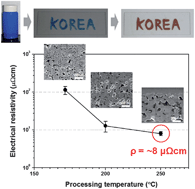Novel inks and pastes based on a copper(II) formate tetrahydrate precursor were formulated with controllable viscosities in the range 5000–10 000 cP for use in printed electrodes. In particular, the addition of ethyl cellulose increased the adhesion of the printed paste films to the glass substrates. For the facile fabrication of electrodes with improved performance, the formulated pastes were printed on glass substrates under ambient conditions by a doctor-blade method. The printed films were thermally sintered at 170–250 °C in air and subsequently reduced under a formic acid atmosphere. The phase and microstructural evolution of the electrode films were systematically investigated by X-ray diffraction (XRD) and cross-sectional, focused ion beam scanning electron microscopy (FIB-SEM) in each processing step. Highly adhesive, polycrystalline Cu electrode films decorated by ethyl cellulose with a vermicular microstructure and large interconnected pore channels were well formed on the glass substrates. The electrode films sintered for 1 min in air and then reduced for 5 min under formic acid atmosphere at 250 °C showed the lowest electrical resistivity of ∼8 μΩ cm (electrical conductivity of ∼125 000 Ω cm−1, equivalent to ∼22% of bulk Cu), despite their maximum porosity of 27.31%.
